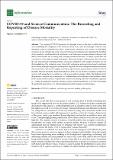Files in this item
COVID-19 and science communication : the recording and reporting of disease mortality
Item metadata
| dc.contributor.author | Arandjelović, Ognjen | |
| dc.date.accessioned | 2022-02-24T13:30:16Z | |
| dc.date.available | 2022-02-24T13:30:16Z | |
| dc.date.issued | 2022-02-18 | |
| dc.identifier | 278039078 | |
| dc.identifier | 2dbf725d-4d4b-4936-a9b5-05d17a46b62a | |
| dc.identifier | 85125015121 | |
| dc.identifier | 000774229600001 | |
| dc.identifier.citation | Arandjelović , O 2022 , ' COVID-19 and science communication : the recording and reporting of disease mortality ' , Information , vol. 13 , no. 2 , e97 . https://doi.org/10.3390/info13020097 | en |
| dc.identifier.issn | 2078-2489 | |
| dc.identifier.other | Jisc: 101529 | |
| dc.identifier.uri | https://hdl.handle.net/10023/24950 | |
| dc.description.abstract | The ongoing COVID-19 pandemic has brought science to the fore of public discourse and, considering the complexity of the issues involved, with it also the challenge of effective and informative science communication. This is a particularly contentious topic, in that it is both highly emotional in and of itself; sits at the nexus of the decision-making process regarding the handling of the pandemic, which has effected lockdowns, social behaviour measures, business closures, and others; and concerns the recording and reporting of disease mortality. To clarify a point that has caused much controversy and anger in the public debate, the first part of the present article discusses the very fundamentals underlying the issue of causative attribution with regards to mortality, lays out the foundations of the statistical means of mortality estimation, and concretizes these by analysing the recording and reporting practices adopted in England and their widespread misrepresentations. The second part of the article is empirical in nature. I present data and an analysis of how COVID-19 mortality has been reported in the mainstream media in the UK and the USA, including a comparative analysis both across the two countries as well as across different media outlets. The findings clearly demonstrate a uniform and worrying lack of understanding of the relevant technical subject matter by the media in both countries. Of particular interest is the finding that with a remarkable regularity (ρ>0.998), the greater the number of articles a media outlet has published on COVID-19 mortality, the greater the proportion of its articles misrepresented the disease mortality figures. | |
| dc.format.extent | 13 | |
| dc.format.extent | 317809 | |
| dc.language.iso | eng | |
| dc.relation.ispartof | Information | en |
| dc.subject | COVID-19 | en |
| dc.subject | Epidemic | en |
| dc.subject | Methodology | en |
| dc.subject | Decision making | en |
| dc.subject | Public policy | en |
| dc.subject | JN101 Great Britain | en |
| dc.subject | QA75 Electronic computers. Computer science | en |
| dc.subject | RA Public aspects of medicine | en |
| dc.subject | 3rd-DAS | en |
| dc.subject.lcc | JN101 | en |
| dc.subject.lcc | QA75 | en |
| dc.subject.lcc | RA | en |
| dc.title | COVID-19 and science communication : the recording and reporting of disease mortality | en |
| dc.type | Journal article | en |
| dc.contributor.institution | University of St Andrews. School of Computer Science | en |
| dc.identifier.doi | 10.3390/info13020097 | |
| dc.description.status | Peer reviewed | en |
This item appears in the following Collection(s)
Items in the St Andrews Research Repository are protected by copyright, with all rights reserved, unless otherwise indicated.

